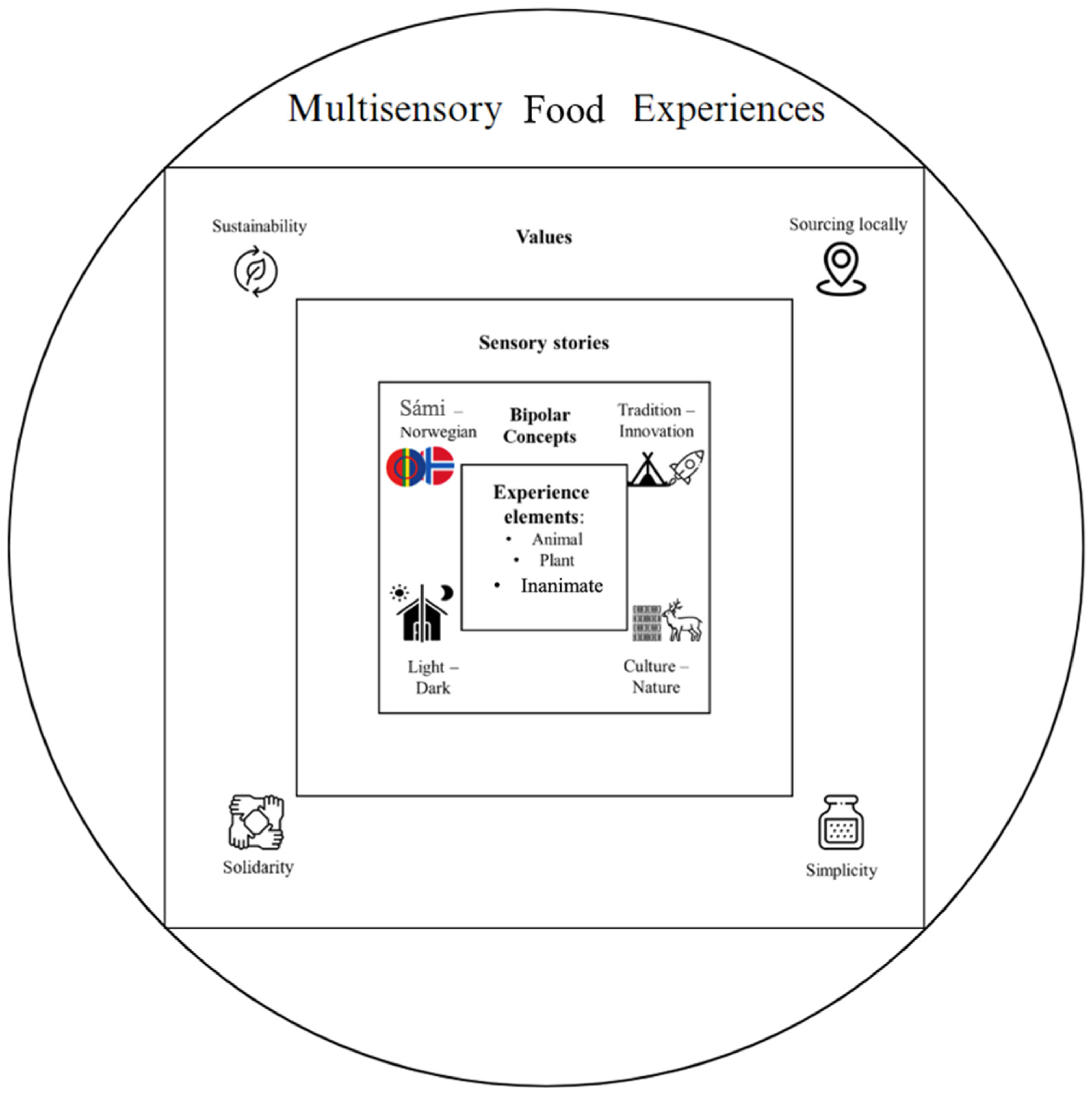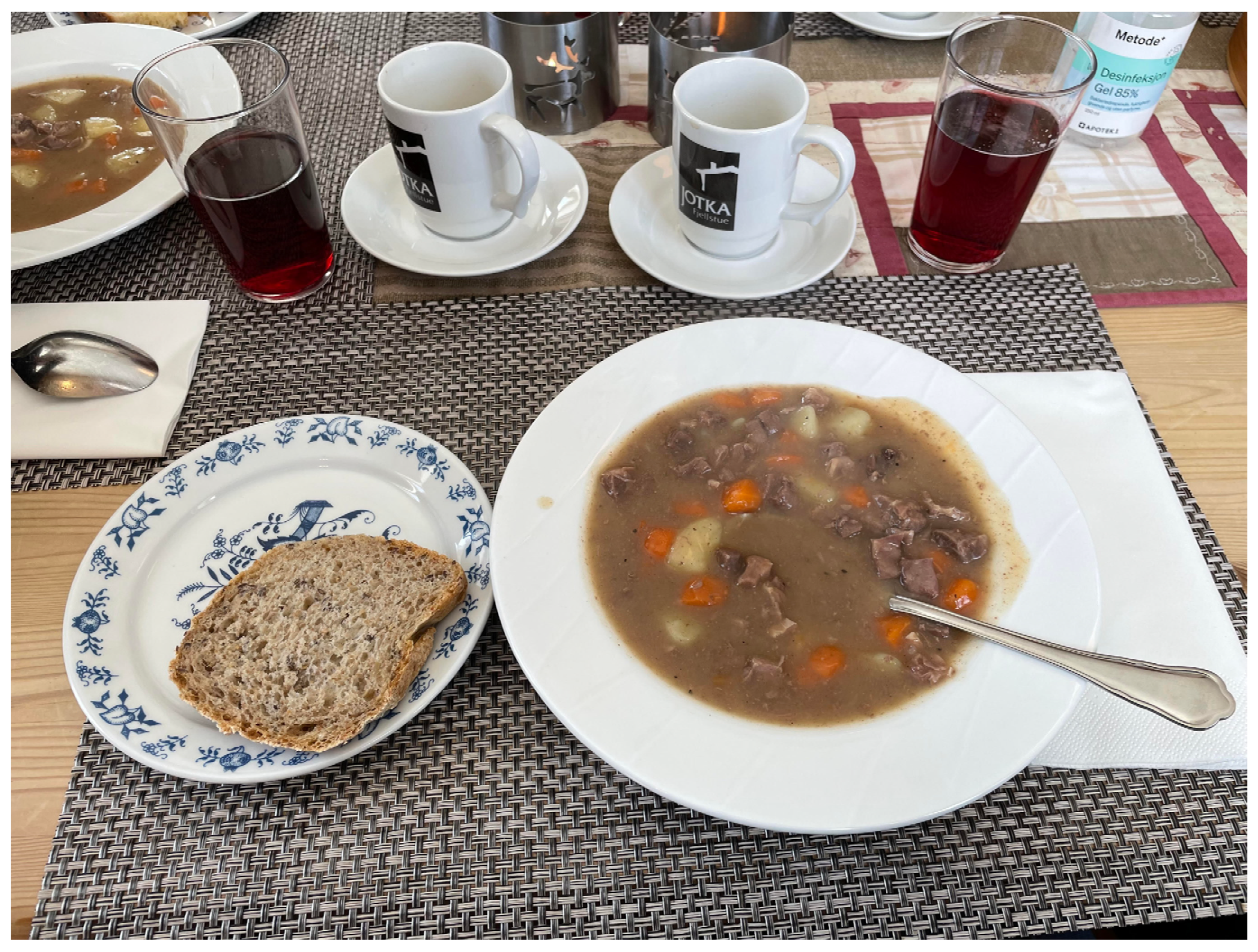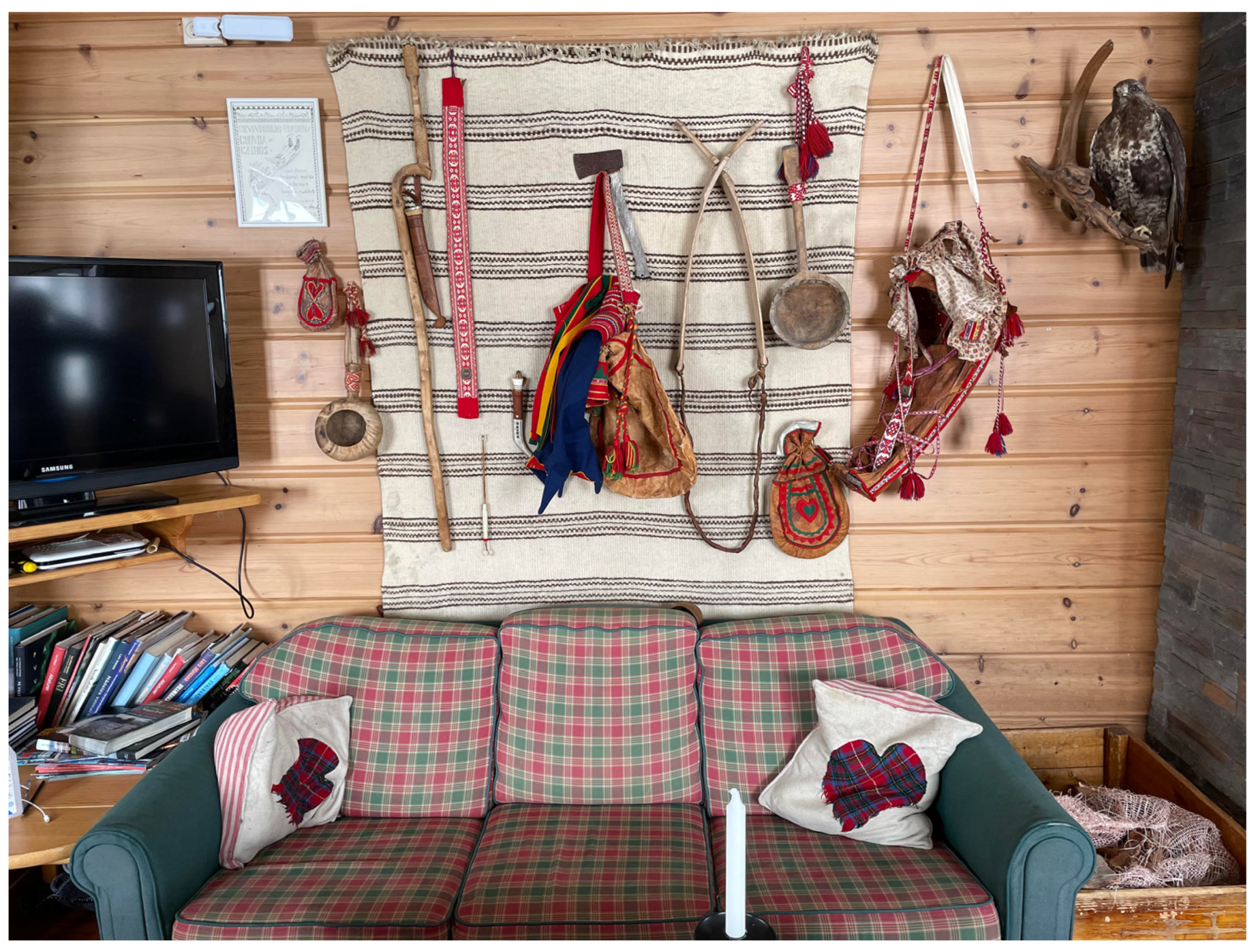Multisensory Food Experiences in Northern Norway: An Exploratory Study
Abstract
1. Introduction
1.1. The Context of Multisensory Food Experiences in Northern Norway
1.2. The Current Research in Multisensory Food Experiences
1.3. Our Aims
2. Method
3. Results: Multisensory Contextual Elements Associated with the Food Experiences
“After walking in the snow for some time, feeling the cold but fresh environment, and the vast and open space full of snow, bright and contrasted with the red wooden cabins, we entered the wooden house. The sound and smell of burning wood is characteristic. The cabin involves much wood material. The sound of the inside and outside merges. The outside involves sounds of cleaning snow from shoes and the entrance, the inside sounds involve crackling wood, voices of chatting people, as well as any interactions with the wood, or later the utensils used to eat. The dining setting minimalistic in a way, but consistently cozy. White plates with textured lines for the main, a more decorated plate for the bread, and later the waffles, and a glass for the drink. Other than the aromas of the Bidos, or later the jams, there’s not much more. The cutlery is metal-based and relatively minimalistic”.
“Around the building there where three lavvos and a fenced area for the reindeers. Two reindeers were outside the fence on a lease. These two were found lost and where to be picked up by the owners. Inside we saw some one-year-old (very hungry, could eat reinlav all day if they were allowed), 4–5 simpler (pregnant reindeer, probably delivering one calf in May (rarely they get twins, most often only one). After the mating period, the males lose their antlers. Then they cannot fight and ends up at the bottom of the hierarchy. The females still have theirs and can protect themselves and the unborn calves. At some point they will lose theirs too”.
“We talked in Norwegian, while drinking coffee and observing the Sámi artifacts on the walls, the knitted socks and mittens for sales and the old pictures probably of her parents and grandparents. After a while Bidos was served in a big pot”.
“Bidos (see Figure 4) is a Sámi feast meal served at special occasions, like weddings, baptizing, confirmation etc. Bidos is reindeer in broth with potatoes and carrot. It was served with black current juice (saft). At weddings often 1000–2000 people were invited. The guest came when they had time. People eat at different times. Convenient with a big pot that was kept warm and where food could be added. As dessert, we got waffles with cloudberry jam, strawberry jam, sour cream and real goat cheese to add. Again, black coffee was served”.
“They explore the surroundings, try the tastes, and come up with novel ideas that, whilst maintaining the Sámi identity in the experience, push forward novel culinary experiences”.
“There seems to be a “tension” between traditional Sámi and the development of new Sámi ways. Informant 1 is sometimes criticized for not using all the Sámi imagery in the products and developments, yet Informant 1 considers themselves as developing the Sámi”.
“The experience starts outside. The tents, the Sámi symbolism, and the reindeer field sets up the stage. In this day of May, the snow and sun create a very bright atmosphere as well [which create a light contrast between indoors and outdoors] (…) The walls are covered with imagery of the previous location which visualizes the tents and the northern lights, as well as images of herds of reindeer. I did not perceive any particular smell but instead, the ample space appears to dissolve them. Once we sat down, in an area where there is a fireplace and cushions with colorful designs, we started talking. We had to change table, though, because the brightness of the outside atmosphere, entered through the window, and was blinding us”.
“Informant 2’s parents was Sámi from the East, the other from the West (without reindeer). Traditionally Sámi people lived on protein alone (fish in the river and reindeer). Potatoes introduced first in 1700. They ate everything (also the belly) of the reindeer and got the vitamin they needed from that”.
“…highlighted how all food comes with storytelling, which is key to the Sámi. Food experiences are not as such without the storytelling it appears. Informant 2 also highlighted the current social nature of the meal in the Sámi, where people gather around the dish, in this case Bidos, to eat and share together”.
“We did not taste anything (only coffee). But his stories made my mouth water. Sounds like he does everything right. He starts with the protein when planning a meal and gives the young chefs his ideas and let them elaborate on them (to add their own tough). They use seasonal raw material. Reindeer is used a lot. From shrimp leftovers he can make different ingredients (in milk, for fermentation (can be used for soup), in oil, powder”.
“…food philosophy is to serve traditional Sámi food made from local raw material”.
“She likes to use the local available resource for her menus. No planning in advance. The menu depends on what she catches or finds during the day. It is spontaneous but it matches with nomadic spirit, appreciating the nature resources and make food accordingly to what is available”.
“The majority of these products are locally sourced and processed, with the theme of ‘Nordic Light’ prominently featured on their labels and packaging”.
“Inspired by the surrounding nature, Informant 2 conceptualizes his dishes by envisioning the primary ingredient and then deliberates on its potential combinations and uses. His creativity shines through in his sustainable methods, such as crafting ice cream powder and sauces from pine trees. He emphasizes that an integral aspect of fine dining is not just the dish itself but the narrative behind it and the element of surprise. This surprise often emerges from his skillful use of ingredients and his unique methods of storage, fermentation, and food processing”.
“Informant 2 highlighted the current social nature of the meal in the Sámi, where people gather around the dish, in this case Bidos, to eat and share together”.
“Informant 2, now a mentor, places great emphasis on recruiting and training local apprentices in his restaurant. He has a strong preference for meats procured from local hunters, as he believes that wild animals, often stress-free, produce tastier meats. For him, quality trumps price; he’s willing to pay whatever the hunter demands, showcasing the depth of trust and connection between them”.
“The simple way to cook and serve is what define Sámi eating experience”.
“Minimalistic in a way, but consistently cozy. White plates with textured lines for the main, a more decorated plate for the bread, and later the waffles, and a glass for the drink. Other than the aromas of the Bidos, or later the jams, there’s not much more. The cutlery is metal-based and relatively simple”.
4. Discussion
4.1. Implications
4.2. Limitations
5. Conclusions
Author Contributions
Funding
Institutional Review Board Statement
Informed Consent Statement
Data Availability Statement
Conflicts of Interest
Appendix A. Observation Guide
- Date and location
- General information about the observation setting: who does it (age, gender), where they do it, what they do
- Relationship to food in Norway/actor type
- Describe the eating experience(s), as detailed as possible.
- What food is eaten?
- Describe the multisensory elements of the experience: its look (sight), sound (hearing), smell, and feel (touch). Describe the elements of both the indoor and outdoor setting.
- How do the experience(s) change with the seasons? Inquire.
- What is eating/food philosophy?
- Notes and comments.
References
- Prescott, J. Multisensory processes in flavour perception and their influence on food choice. Curr. Opin. Food Sci. 2015, 3, 47–52. [Google Scholar] [CrossRef]
- Betancur, M.I.; Motoki, K.; Spence, C.; Velasco, C. Factors influencing the choice of beer: A review. Food Res. Int. 2020, 137, 109367. [Google Scholar] [CrossRef]
- Wang, Q.J.; Mielby, L.A.; Junge, J.Y.; Bertelsen, A.S.; Kidmose, U.; Spence, C.; Byrne, D.V. The role of intrinsic and extrinsic sensory factors in sweetness perception of food and beverages: A review. Foods 2019, 8, 211. [Google Scholar] [CrossRef] [PubMed]
- Spence, C.; Youssef, J. Synaesthesia: The multisensory dining experience. Int. J. Gastron. Food Sci. 2019, 18, 100179. [Google Scholar] [CrossRef]
- Henrich, J.; Heine, S.J.; Norenzayan, A. Most people are not WEIRD. Nature 2010, 466, 29. [Google Scholar] [CrossRef]
- Bremner, A.J.; Caparos, S.; Davidoff, J.; de Fockert, J.; Linnell, K.J.; Spence, C. “Bouba” and “Kiki” in Namibia? A remote culture make similar shape–sound matches, but different shape–taste matches to Westerners. Cognition 2013, 126, 165–172. [Google Scholar] [CrossRef] [PubMed]
- Velasco, C.; Obrist, M. Multisensory experiences: A primer. Front. Comput. Sci. 2021, 3, 12. [Google Scholar] [CrossRef]
- Welter, F. Contextualizing entrepreneurship—Conceptual challenges and ways forward. Entrep. Theory Pract. 2011, 35, 165–184. [Google Scholar] [CrossRef]
- Welter, F.; Baker, T.; Audretsch, D.B.; Gartner, W.B. Everyday entrepreneurship—A call for entrepreneurship research to embrace entrepreneurial diversity. Entrep. Theory Pract. 2017, 41, 311–321. [Google Scholar] [CrossRef]
- Ben-Hafaïedh, C.; Xheneti, M.; Stenholm, P.; Blackburn, R.; Welter, F.; Urbano, D. The interplay of context and entrepreneurship: The new frontier for contextualisation research. Small Bus. Econ. 2023, 62, 571–582. [Google Scholar] [CrossRef]
- Sentralbyrå, S. Regional Population Projections. 2022. Retrieved 07/09. Available online: https://www.ssb.no/en/befolkning/befolkningsframskrivinger/statistikk/regionale-befolkningsframskrivinger (accessed on 7 September 2023).
- Kelman, I.; Næss, M.W. Climate change and migration for Scandinavian Saami: A review of possible impacts. Climate 2019, 7, 47. [Google Scholar] [CrossRef]
- Petrenya, N.; Skeie, G.; Melhus, M.; Brustad, M. Food in rural northern Norway in relation to Sami ethnicity: The SAMINOR 2 Clinical Survey. Public Health Nutr. 2018, 21, 2665–2677. [Google Scholar] [CrossRef]
- Sjøvold, T. The Iron Age Settlement of Arctic Norway: A Study in the Expansion of European Iron Age Culture within the Arctic Circle—Vol. I, Early Iron Age (Roman and Migration Periods); Norwegian Universities Press: Oslo, Norway, 1962; Volume 10. [Google Scholar]
- Mølmann, J.A.; Dalmannsdottir, S.; Hykkerud, A.L.; Hytönen, T.; Samkumar, A.; Jaakola, L. Influence of Arctic light conditions on crop production and quality. Physiol. Plant. 2021, 172, 1931–1940. [Google Scholar] [CrossRef]
- Virtanen, P.; Keskitalo, P.; Olsen, T. Indigenous Research Methodologies in Sámi and Global Contexts; Brill: Leiden, The Netherlands, 2021. [Google Scholar]
- Gaski, H. (Ed.) Sami Culture in a New Era: The Norwegian Sami Experience; The University of Washington Press: Washington, DC, USA, 1997. [Google Scholar]
- Pietikäinen, S. Sami in the media: Questions of language vitality and cultural hybridisation. J. Multicult. Discourses 2008, 3, 22–35. [Google Scholar] [CrossRef]
- Bull, T. Language maintenance and loss in an originally trilingual area in North Norway. Int. J. Sociol. Lang. 1995, 1995, 125–134. [Google Scholar] [CrossRef]
- Selle, P.; Semb, A.J.; Strømsnes, K. Citizenship identity among Norwegian Sami in core Sami areas. Citizsh. Stud. 2013, 17, 712–727. [Google Scholar] [CrossRef]
- Trueworthy, A.A. Beyond Rudolph: The Cultural Impacts of Reindeer Herding on the Sami Young Historians Conference; Portland State University: Portland, OR, USA, 2022. [Google Scholar]
- Jaakkola, J.J.; Juntunen, S.; Näkkäläjärvi, K. The holistic effects of climate change on the culture, well-being, and health of the Saami, the only indigenous people in the European Union. Curr. Environ. Health Rep. 2018, 5, 401–417. [Google Scholar] [CrossRef]
- Mossberg, L.; Eide, D. Storytelling and meal experience concepts. In Nordic Food Transitions; Routledge: London, UK, 2018; pp. 84–99. [Google Scholar]
- Prebensen, N.K.; Woo, E.; Chen, J.S.; Uysal, M. Experience quality in the different phases of a tourist vacation: A case of northern Norway. Tour. Anal. 2012, 17, 617–627. [Google Scholar] [CrossRef][Green Version]
- Sthapit, E. Memories of gastronomic experiences, savoured positive emotions and savouring processes. Scand. J. Hosp. Tour. 2019, 19, 115–139. [Google Scholar] [CrossRef]
- Velasco, C.; Obrist, M. Multisensory Experiences: Where the Senses Meet Technology; Oxford University Press: Oxford, UK, 2020. [Google Scholar]
- Velasco, C.; Spence, C. The multisensory analysis of product packaging framework. In Multisensory Packaging: Designing New Product Experiences; Palgrave McMillan: Basingstoke, UK, 2019; pp. 191–223. [Google Scholar]
- Lemon, K.N.; Verhoef, P.C. Understanding customer experience throughout the customer journey. J. Mark. 2016, 80, 69–96. [Google Scholar] [CrossRef]
- Spence, C. Multisensory flavour perception: Blending, mixing, fusion, and pairing within and between the senses. Foods 2020, 9, 407. [Google Scholar] [CrossRef]
- Kauppinen-Räisänen, H.; Gummerus, J.; Lehtola, K. Remembered eating experiences described by the self, place, food, context and time. Br. Food J. 2013, 115, 666–685. [Google Scholar] [CrossRef]
- Tran, H.; Veflen, N.; Reinoso-Carvalho, F.; Tabassum, F.; Velasco, C. Seasonal multisensory eating experiences in Norway and Colombia. Food Qual. Prefer. 2023, 109, 104873. [Google Scholar] [CrossRef]
- Sønstebø, A. Samisk Statistikk 2022. S. Sentralbyrå. 2022. Available online: https://www.ssb.no/befolkning/folketall/artikler/samisk-statistikk-2022/_/attachment/inline/f875051e-8543-463f-bb4f-e58045a99dbb:1b198daa0fe0ec2b8700eb521ea17e420c14009e/RAPP2022-05_web.pdf (accessed on 7 September 2023).
- Institutt, M. Historic Temperature; Norwegian Meteorological Institute and NRK: Oslo, Norway, 2023; Available online: https://www.yr.no/nb (accessed on 7 September 2023).
- Guest, G.; Namey, E.E.; Mitchell, M.L. Collecting Qualitative Data: A Field Manual for Applied Research; Sage: Thousand Oaks, CA, USA, 2013. [Google Scholar]
- Laitinen, H.; Kaunonen, M.; Åstedt-Kurki, P. Methodological tools for the collection and analysis of participant observation data using grounded theory. Nurse Res. 2014, 22, 10–15. [Google Scholar] [CrossRef]
- Alvarado, J.A.; Velasco, C.; Salgado, A. The organization of semantic associations between senses in language. Lang. Cogn. 2024, in press. [Google Scholar] [CrossRef]
- Osgood, C.E.; Suci, G.J.; Tannenbaum, P.H. The Measurement of Meaning; University of Illinois Press: Urbana, IL, USA, 1957. [Google Scholar]
- Velasco, C.; Tu, Y.; Obrist, M. Towards multisensory storytelling with taste and flavor. In Proceedings of the 3rd International Workshop on Multisensory Approaches to Human-Food Interaction, Boulder, CO, USA, 16 October 2018; pp. 1–7. [Google Scholar]
- Spence, C. Gastrophysics: The New Science of Eating; Penguin: London, UK, 2017. [Google Scholar]





Disclaimer/Publisher’s Note: The statements, opinions and data contained in all publications are solely those of the individual author(s) and contributor(s) and not of MDPI and/or the editor(s). MDPI and/or the editor(s) disclaim responsibility for any injury to people or property resulting from any ideas, methods, instructions or products referred to in the content. |
© 2024 by the authors. Licensee MDPI, Basel, Switzerland. This article is an open access article distributed under the terms and conditions of the Creative Commons Attribution (CC BY) license (https://creativecommons.org/licenses/by/4.0/).
Share and Cite
Tran, H.; Veflen, N.; Jørgensen, E.J.B.; Velasco, C. Multisensory Food Experiences in Northern Norway: An Exploratory Study. Foods 2024, 13, 2156. https://doi.org/10.3390/foods13132156
Tran H, Veflen N, Jørgensen EJB, Velasco C. Multisensory Food Experiences in Northern Norway: An Exploratory Study. Foods. 2024; 13(13):2156. https://doi.org/10.3390/foods13132156
Chicago/Turabian StyleTran, Huy, Nina Veflen, Eva J. B. Jørgensen, and Carlos Velasco. 2024. "Multisensory Food Experiences in Northern Norway: An Exploratory Study" Foods 13, no. 13: 2156. https://doi.org/10.3390/foods13132156
APA StyleTran, H., Veflen, N., Jørgensen, E. J. B., & Velasco, C. (2024). Multisensory Food Experiences in Northern Norway: An Exploratory Study. Foods, 13(13), 2156. https://doi.org/10.3390/foods13132156





